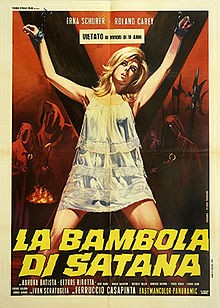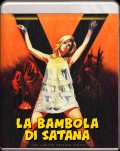| Reviews & Columns |
|
Reviews DVD TV on DVD Blu-ray 4K UHD International DVDs In Theaters Reviews by Studio Video Games Features Collector Series DVDs Easter Egg Database Interviews DVD Talk Radio Feature Articles Columns Anime Talk DVD Savant Horror DVDs The M.O.D. Squad Art House HD Talk Silent DVD
|
DVD Talk Forum |
|
|
| Resources |
|
DVD Price Search Customer Service #'s RCE Info Links |
|
Columns
|
|
|
La bambola di Satana (Satan's Doll)
What's strange about La bambola di Satana is that precious little about it is exploitable. There are no recognizable names in the cast, no Barbara Steele or John Saxon, for instance. Director Ferruccio Casapinta is totally unknown, and as far as this reviewer can tell, the picture had no theatrical release in the United States at all, and not much outside of Italy.
Despite mixed-to-negative reviews elsewhere it's not a bad little thriller. It has a fairly solid if familiar plot. It tries hard to generate some atmosphere here and there, and unlike many cheap Italian exploitation pictures La bambola di Satana is competently made, if at times too low-budget for its ambitions. Watching it, one can't help but wonder what a Mario Bava or Dario Argento might have done with the same script. But, for what it is, the picture is far from terrible, and this reviewer is grateful for the opportunity to have seen it.
Further, the high-definition transfer is great, a restoration credited to Lucertola Media, a German company. Considering its extremely limited release outside Italy, it's possible fewer than a dozen prints were ever struck, so there are almost no signs of wear-and-tear. Busy David Del Valle and Derek Botelho provide its audio commentary track.
Pretty blonde Elizabeth (Erna Schürer) arrives at her late uncle's castle for a reading of his will. Her journalist fiancé, Jack (Roland Carey), and two friends, Gérard (Giorgio Gennari) and Blanche (Beverly Fuller? Cast lists are unclear), accompany her.
At the Belljanon Castle (Castle Borghese near Rome), the "governess," Mademoiselle* Carol (Lucia Bomez) expresses displeasure at having to care for all these strangers, in addition to caring for the once-beautiful, now-mute, invalid, and supposedly insane Janette (Teresa Ronchi?), Sir Balljanon's former secretary. The will is read and, sure enough, Elizabeth is the sole beneficiary. She wants to sell the castle and Carol has already found a buyer in wealthy neighbor Reynaud (Ettore Ribotta), but an old associate of her uncle, Mr. Shinton (Domenico Ravenna) claims to have documents proving that Sir Balljanon would never have wanted to sell the estate.
Soon after, a mysterious man dressed in black murders him. Meanwhile, a young painter, Claudine (Aurora Bautista) suspiciously hangs around the castle and late one night sneaks into its catacombs and takes readings on what's supposed to be a Geiger counter but clearly isn't. Elsewhere, at the local café and teen hangout (a Silver-VOX jukebox gets more close-ups than most of the cast), Stephan (Franco Daddi), a Timothy Carey-type, glares at everyone and is clearly up to no good.
Mario Bava's excellent The Girl Who Knew Too Much (aka The Evil Eye, 1963) is generally regarded as the first giallo film, named after the yellow paperback thrillers popular in Italy at the time. As a genre, giallo really took off in the 1970s with occasionally very stylish, Hitchcockian thrillers, the best of which still hold up extremely well today. But in 1969, judging by the likes of La bambola di Satana, the genre will still in its formative years, still influenced by gothic horror films and, to a lesser degree, West German mysteries exemplified by Rialto's delightful Edgar Wallace series. Some reviewers describe it as a poorly made gothic, but the picture is really closer in spirit to a mystery-thriller with slight horror elements, like most of the Edgar Wallaces.
La bambola di Satana is clearly cheap, but its budget probably was about par with the average Bava picture, so its general absence of Bava's stylish compositions, masterly lighting, and constant inventiveness is unfortunate, but at least it's screenplay gets from point A to point B competently. An establishing shot, of the castle with violet clouds hovering about it (and probably painted on glass) clearly shows Bava's influence. The film is relatively tame, with little blood and almost demure nudity, and model-turned-actress Schürer clearly isn't up to the task acting-wise, but some of the other performances are good and the film is strangely likeable with a kind of quaint charm.
Director Casapinta, a better writer than a director, seems to have made no other films. According to Wikipedia, actress Schürer recalled the film's assistant director was actually the man calling the shots as Casapinta "was an idiot who couldn't do anything."
Video & Audio
Considering its obscurity, La bambola di Satana looks great. The 1080p, 1.85:1 widescreen transfer shows almost no signs of damage, the color is excellent, and except for a few out-of-focus shots exhibits impressive detail. The film is presented in Italian only (1.0 DTS-HD Master Audio) with optional English subtitles. (One wonders if an English-dubbed version was ever prepared.) The subtitles have their share of awkward grammar and other minor mistakes (like referring to housekeeper Carol as a governess) but otherwise are fine. The disc is region-free and limited to 3,000 copies.
Extra Feature
Supplements include an isolated music and effects track. Franco Potenza's score is quite awful, but it's nice that it was included. The main draw is the audio commentary track, by De Valle and Botelho, the latter the author of The Argento Syndrome.
Final Thoughts
Though an extremely minor and obscure jumble of giallo, gothic horror, and mystery-thriller aspects, La bambola di Satana is still a welcome release. Fans of all but Italian gothic horror films should find it a better film than they might have expected and, for them, it's Recommended.
* Like many Italian horror-suspense films, the setting has, apparently, been moved to France.
Stuart Galbraith IV is the Kyoto-based film historian and publisher-editor of World Cinema Paradise. His new documentary and latest audio commentary, for the British Film Institute's Blu-ray of Rashomon, is now available.
|
| Popular Reviews |
| Sponsored Links |
|
|
| Sponsored Links |
|
|
| Release List | Reviews | Shop | Newsletter | Forum | DVD Giveaways | Blu-Ray | Advertise |
|
Copyright 2024 DVDTalk.com All Rights Reserved. Legal Info, Privacy Policy, Terms of Use,
Manage Preferences,
Your Privacy Choices | |||||||















